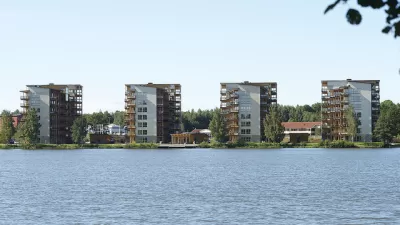The beginning of 2015 saw changes to Toronto's building code that will allow wood construction up to six stories. Supporters of the code change see multiple potential benefits from the code change.
"New rules went into effect Thursday allowing developers to construct wood-frame buildings up to six storeys," reports Luke Simcoe. "The height restriction had previously been capped at four due to safety concerns."
"Although two extra storeys may not seem like much…the code change could spur a mid-rise housing boom in the city," explains Simcoe, thanks to the savings offered by wood construction as compared to cement.
Simcoe quotes Paul Stevens, a principal at ZAS Architects in Toronto, who also explains that wood construction "allows for more creative building forms, and…the change could bring variety to a Toronto skyline dominated by concrete condos."
FULL STORY: New rules could shift face of Toronto skyline, affordable housing

Alabama: Trump Terminates Settlements for Black Communities Harmed By Raw Sewage
Trump deemed the landmark civil rights agreement “illegal DEI and environmental justice policy.”

Study: Maui’s Plan to Convert Vacation Rentals to Long-Term Housing Could Cause Nearly $1 Billion Economic Loss
The plan would reduce visitor accommodation by 25% resulting in 1,900 jobs lost.

Why Should We Subsidize Public Transportation?
Many public transit agencies face financial stress due to rising costs, declining fare revenue, and declining subsidies. Transit advocates must provide a strong business case for increasing public transit funding.

Paris Bike Boom Leads to Steep Drop in Air Pollution
The French city’s air quality has improved dramatically in the past 20 years, coinciding with a growth in cycling.

Why Housing Costs More to Build in California Than in Texas
Hard costs like labor and materials combined with ‘soft’ costs such as permitting make building in the San Francisco Bay Area almost three times as costly as in Texas cities.

San Diego County Sees a Rise in Urban Coyotes
San Diego County experiences a rise in urban coyotes, as sightings become prevalent throughout its urban neighbourhoods and surrounding areas.
Urban Design for Planners 1: Software Tools
This six-course series explores essential urban design concepts using open source software and equips planners with the tools they need to participate fully in the urban design process.
Planning for Universal Design
Learn the tools for implementing Universal Design in planning regulations.
Smith Gee Studio
Alamo Area Metropolitan Planning Organization
City of Santa Clarita
Institute for Housing and Urban Development Studies (IHS)
City of Grandview
Harvard GSD Executive Education
Toledo-Lucas County Plan Commissions
Salt Lake City
NYU Wagner Graduate School of Public Service



























